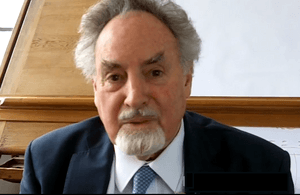Geoffrey Burnstock facts for kids
Quick facts for kids
Geoffrey Burnstock
|
|
|---|---|
 |
|
| Born | 10 May 1929 London, England
|
| Died | 2 June 2020 (aged 91) Melbourne, Victoria, Australia
|
| Nationality | Australian |
| Alma mater | King's College London University College London |
| Awards | Royal Medal (2000) FRS (1986) |
| Scientific career | |
| Fields | Purinergic signalling |
| Institutions | UCL Medical School |
Geoffrey Burnstock (born May 10, 1929 – died June 2, 2020) was a very important scientist. He studied the nervous system and how it works. He was also the President of the Autonomic Neuroscience Centre at the UCL Medical School.
He is famous for discovering something called "purinergic signalling" in the 1970s. This discovery helped us understand how our body's cells talk to each other. He retired in October 2017 when he was 88 years old.
Contents
About His Life and Work
Geoffrey Burnstock went to Greenford County School. He then studied at King's College London and University College London. He earned his first degree in 1953 and his PhD in 1957.
He played a big part in finding out that a molecule called ATP acts like a messenger in our bodies. In 1959, he became a senior lecturer at Melbourne University in Australia. Later, in 1964, he became a professor there.
In 1975, he moved back to London. He became the head of a department at UCL. He also helped start the Center of Neuroscience. From 1997, he directed the Autonomic Neuroscience Institute.
Awards and Recognition
Burnstock received many important awards for his work. He was chosen to be part of the Australian Academy of Science in 1971. In 1986, he became a Fellow of the Royal Society. He also joined the Academy of Medical Sciences in 1998.
He was given honorary titles from the Royal College of Surgeons and the Royal College of Physicians. In 2000, he received the Royal Society Gold Medal.
He was the first president of the International Society for Autonomic Neuroscience. He also led a science journal called Autonomic Neuroscience: Basic and Clinical.
His Research and Publications
Professor Burnstock guided over 100 students who were getting their PhD or MD degrees. He wrote more than 1,400 scientific papers, reviews, and books. For many years, from 1994 to 2004, he was one of the most cited scientists in his field. This means his work was often referenced by other scientists.
He was also the main editor for the Purinergic Signalling journal. In 2017, he received the Macfarlane Burnet Medal from the Australian Academy of Science. This award recognized his amazing research in biological science.
Geoffrey Burnstock passed away on June 2, 2020, at the age of 91.
His Lasting Impact
Professor Burnstock's important work on ATP-related signalling began in the 1970s. His discoveries made many other scientists interested in this area. Because of his work, he became the most cited scientist in pharmacology and toxicology for several years in the 2000s.
Most of what we know today about purinergic signalling comes from his research. He also helped classify the different types of purinergic receptors. These are like tiny receivers on cells that pick up signals. He was also the first president of the International Society for Autonomic Neuroscience.
The New York Times newspaper said that Burnstock was "the scientist who brought ATP into the world of brain research." This shows how important his discoveries were.
See also
 In Spanish: Geoffrey Burnstock para niños
In Spanish: Geoffrey Burnstock para niños
- Gefapixant, a medicine named in honor of Burnstock.

